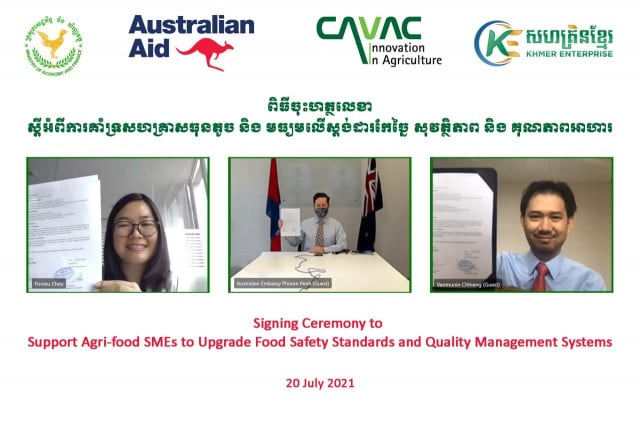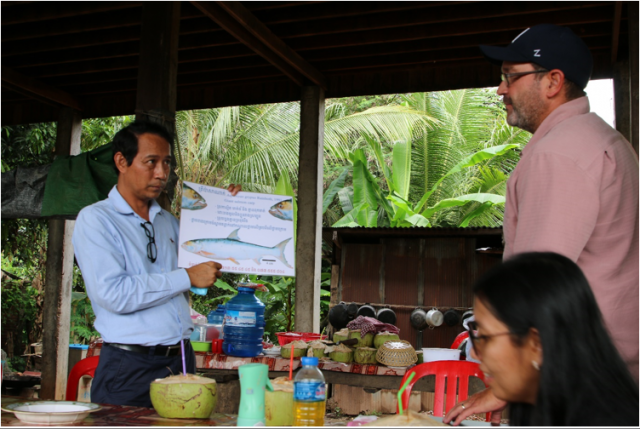Tboung Khmum’s Tobacco Farmers Defy the Hardships

- By Isa Rohany
- March 20, 2024 2:10 PM
TBOUNG KHMUM – Farming tobacco might be harder than other crops but residents of Tboung Khmum province’s Svay Khleang commune depend on it for a living, passing down skills and traditions through generations.
Consistently flooded during the rainy season, Svay Khleang of Krouch Chhmar district is favorable for agriculture, particularly for planting corn, tobacco and beans thank to the rich of sediments deposited from the Mekong River.
The villagers grow two types of tobacco: thnam Khmer or thnam klaing and thnam katab.
From the end of February or early March, the commune’s residents mostly spend their time in their tobacco fields as it is harvest time, especially for Khmer tobacco.
During this season, farmers are so busy that some don’t even have time to eat properly or rest. Growing tobacco keeps residents busy from planting seeds to growing and harvesting.
Drying tobacco leaves on the football ground behind the village, Mat Habsoh looks extremely tired due to the overwhelming tasks. The work requires the 40-year-old to undertake many tasks beyond her physical capabilities.
In villages, there are few people doing the work. Some are busy with their own farms while some younger ones are studying or working outside the district. This poses difficulties for farmers like Habsoh during harvesting.
Some farmers have to join hands with others, taking turns to help each other.
Habsoh also rents land from other farmers for $3,000 a year. With a total of five hectares, three are used for tobacco and two for growing corn.
“If we grow all tobacco, we won't have enough labor. Growing corn is not difficult, but the price of corn is low,” Habsoh said.
Habsoh takes about one month to harvest tobacco. During this time, she lacks time for rest and occasionally becomes sick. At night, she sleeps for four hours.
“During the day I work from 1 to 8pm and go to bed around 9pm. I wake up at 1am to slice and dry tobacco leaves until 7am. Then I collect tobacco leaves,” she said.
Arifin faces the same issue. He doesn’t have enough labor force to help him, other than his children and wife.
This year, he is growing about 40,000 tobacco plants. While having a fruitful harvesting season, the 60-year-old doesn’t expect more income than the previous year because he spent a lot of money on labor for work including cutting, slicing and drying the leaves.
Despite growing tobacco being such demanding work with unstable prices, Habsoh and Arifin don’t want to give up on growing tobacco.
Growing 20,000 tobacco plants, Mariam, a third-generation tobacco farmer, said this year’s yields are better than last year and the price is satisfyingly high for farmers.
However, she said costs had also increased. “From year to year, we have to spend all the money. We are left little. But it is our only business,” she said.
Dried tobacco could be sold for between 19,000 and 20,000 riel per kilogram at the early period of the harvest depending on the quality. Some farmers think it is acceptable while they also want money to meet their expenses.
Deputy Tboung Khmum governor and spokesperson Hok Pichhors said the tobacco market is good in Krouch Chhmar district. Katab costs 10,000 to 20,000 riel per kilo, and Khmer tobacco costs up to 20,000 riel. Pichhors said the prices are higher than in the previous year.
Cambodia exports 70 to 80 percent of its tobacco to Vietnam, its top export market, and two to five percent to China. About 25 percent is sold locally. Pichhors said 1,600 families farm 1,385 hectares of tobacco fields.
Originally written in Khmer for ThmeyThmey, this article was translated by Nhor Sokhoeurn for Cambodianess.















